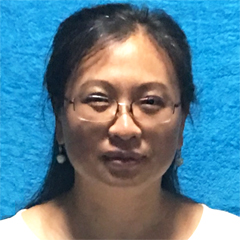
Abstract:
Prof. Lin Han, Qilu young scholar, Shandong University; winners of National Science Fund for Outstanding Young Scholars in Shandong Province; Professor of Marine institute of school, Shandong University.
Prof. Han majored in microelectronics, biomedical interdisciplinary field. She focuses on the research in the interdisciplinary of bio-molecular information and microelectronics, study the single-celled or extremely low concentration biomolecules through microfluidic platform. The advantages of microfluidic platform include high throughput, small sample volume consuming, high reliability and sensitivity. Prof. Han has published more than 30 scientific papers in international journals, including Nucleic Acids Research, Scientific Reports, Applied Physics Letters, IEEE Electronic Devices Letts, PNAS, Nano Letters, ACS Nano, etc. She has applied for 9 U.S. patents, 8 Chinese patents, and 2 international patents, including 4 authorized USA patents. Prof. Han joined Department of Biomedical Engineering at Yale University after Ph.D graduation, and continued her research in the development for single-cell bio-information analysis system based on microfluidic chip. She took advantages of her microelectronic technology and biology knowledge, and achieved a number of innovations. The research project has won several major research grants, including the Connecticut Stem Cell Fund, the United States national institutes of health (NIH), David and Lucile Packard Foundation, etc. The microfluidic chip was successfully designed and fabricated to extract the whole genome information of single cells, which can simultaneously extract the DNA and mRNA of single cells and carry out amplification.
In October 2015, Prof. Han was appointed as a chief scientist in a biotech company of Isoplexis. She has contributed greatly to develop high flux single-cell secretory protein chip, and designed high-throughput microfluidics, which could detect more than 42 proteins secretion from thousands of living cells. The chip has drawn intensive attention from a number of well-known bioanalysts, pharmaceutical companies such as Bio-Rad, Novartis and Merck.
Experiences:
Ph.D. , Department of Electrical Engineering, Princeton University (2011)
Postdoctoral Fellow, Department of Biomedical Engineering, Yale University (2011-2015)
Associate Research Scientist, Department of Biomedical engineering, Yale University (2015)
Chief scientist, Isoplexis company, USA (2015-2016)
Outstanding Youth Funding, Shandong Province (2018)
Qilu Young Scholar, Shandong University (2016)
Professor , Shandong University (2016-)
Research Interests:
Interdisciplinary research in integration of microelectronics, nanomaterials, and bio-sensing, including detection chips of cancer biomarkers in early stage, Function evaluation chips and system for CAR-T therapy, and chips in applications in Marine microorganism etc.
New flexible electronic materials and devices, including new 2D materials and devices, wearable electronics, sensing devices and system for artificial intelligence electronic skin.
Selected Publications:
1. L. Han, H. Wu, et al., Bisulfite-independent analysis of CpG island methylation enables genome-scale stratification of single-cells, Neucleic Acids Research, Doi:10.1093lnarlgkxo26, Jan. 2017
2. M. Kwak# , L. Han#, , J. Chen, R. Fan* , Interfacing Nanowire arrays and living cells for cellular functionanalysis;SMALL; 11(42):226-228, 2015
3. Kwak M. Kim DJ, Han L, Lee MR, Wu Y, Lee SK, and Fan R, Capture and multiplexed molecular typing of rare trafficking leukocytes via a biofunctionalized nanowire array, Nanoscale, vol.6(12), p. 6537, 2014
4. L. Han, Y. Huang, J.C. Sturm, and S. Wagner, “Self-aligned top-gate coplanar a-Si:H thin film transistors with a SiO2-silicone hybrid gate dielectric”, IEEE Electron Device Letters (EDL 2010), vol. 32, p. 36, 2010
5. [Invited] L. Han, K. Song, P. Mandlik, and S. Wagner, “A new insulator for thin-film transistor backplanes and for flexible passivation layers”, Electrochemical Society Transaction (ECST 2010), vol. 33, p. 125, 2010
6. L. Han, K. Song, P. Mandlik, and S. Wagner, “Ultraflexible amorphous silicon transistors made with a resilient insulator”, Applied Physics Letters, (APL 2010), vol. 96, pp. 042111, 2010
7. L. Han, P. Mandlik, K. Cherenack and S. Wagner, “Amorphous silicon thin-film transistors with field effect mobilities of 2 cm2/Vs for electrons and 0.1 cm2/Vs for holes”, Applied Physics Letters, (APL 2009), vol. 94, pp. 162105, 2009
8. L. Han, P. Mandlik and S. Wagner, “A new gate dielectric for highly stable amorphous-silicon thin-film transistors with 1.5 cm2/Vs electron field-effect mobility”, IEEE Electron Device Letters (EDL 2009), vol. 30, pp. 502, 2009
9. L. Han, P. Mandlik, J. Gartside, S. Wagner, J. Silvernail, R. Ma, M. Mack and J. J. Brown, “Properties of a new permeation barrier material deposited from hexamethyl disiloxane and oxygen”, J. Electrochem. Soc., (JECS-2009), Vol. 156, pp. H106, 2009
10. P. Mandlik, L. Han, S. Wagner, J. Silvernail, R. Ma, M. Hack and J. J. Brown, “Diffusion of atmospheric gases into barrier-layer sealed organic light emitting diodes”, Applied Physics Letters, (APL 2008), vol. 93, pp. 203306, 2008
E-mail: hanlin@sdu.edu.cn lin_han22@163.com
